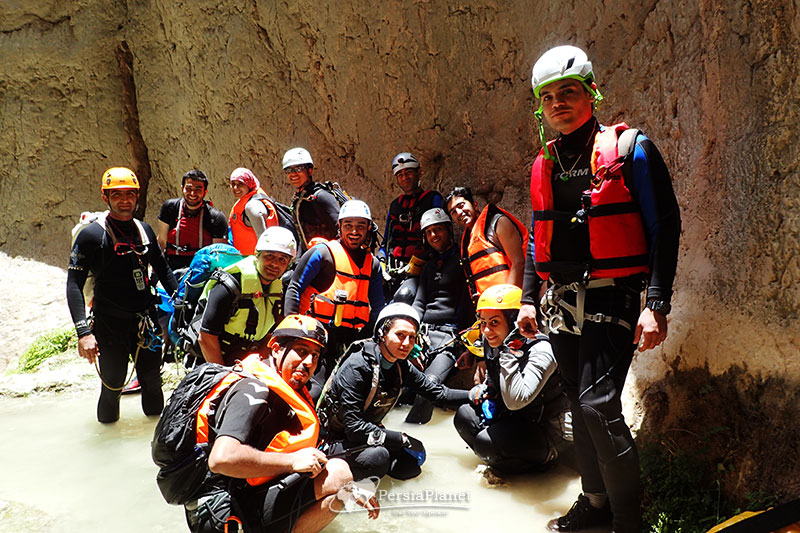Iran Canyoning
Entering canyons has been done for many years for various purposes, including military use, access to water and food resources. For example, in some impenetrable castles on the walls, canyons were used for passage routes or water withdrawal or escape routes, such as Malek Bahman Castle in Shahandasht, Alamut Castle in Gazarkhan and Dokhtar Castle Pointed in Mianeh. Over the years, people entered impassable canyons in different ways for different purposes, from adventure to treasure hunting.

History of Canyoning in Iran
History of entering the technical and vertical canyons and access with rope in 1953, at the same time with the construction of Karaj Dam (Amirkabir) and the establishment of the army in that place. The army entered a canyon called Takavaran. The canyon has 4 waterfalls that have water only 3 months of the year, and now it is the training place of the Army Commandos. For the first time, two military men named Mr. Vaziri and Mr. Mortazavi try to identify the Andersem canyon in Mazandaran, but after the second waterfall, they are forced to leave the canyon. In July 1983, Team Two Individuals led by the late Reza Aghmasheh and Hossein Sami succeed in entering the canyon.
In 1994, the "Darab Gerd" group, led by Mr. Abdolmohammadi, opened the Raghez canyon in Fars province. In 2001, the Tehran Mountaineers' House Group opened the Kamjel Valley in the Siah Bisheh area of Mazandaran. In the 80's, many canyons were opened and every year, with the discovery and opening of new routes, this sport expanded more.
August 2005 The biggest tragedy of canyoning and mountaineering in Iran took place, an 11-member team from Qazvin Family and Nature Club in "Andersem" valley of Chalous road was involved in an accident due to floods and all of them died.
In September 2009, the search and rescue course of the valley was held by the U.S.Search And Rescue Organization, hosted by Damavand Club of Tehran, under the tutelage of Majid Sabetzadeh in the Shahan Dasht area
Until the late eighties, canyoning was based on the knowledge of climbing and with the same techniques and ropes. At this time, groups engaged in more specialized activities related to canyoning and tried to update canyoning techniques and more openings.
In the spring of 2011, the first national valley climbing conference was held in Neishabour and in the summer of the same year, the second conference was held in Karaj. The achievement of these conferences was the need to teach the knowledge of the day of canyoning. In this regard, in the fall of 2012, hosted by the Isfahan Mountaineering Board and Arad Mountaineering Group, the official canyoning course was held by the American Academy of Canoeing (ACA) in Isfahan under Richard Carlson. .
In the summer of 2013, the third national valley climbing conference was held at the Federation headquarters in Plour, and in the winter of the same year, the first joint rescue maneuver in the valley was held by the Red Crescent and ACA participants.
In 2013, for the first time in the Mountaineering and Climbing Federation of Iran, the canyon section was set up. Currently in Iran.

Women's canyoning in Iran
canyoning is one of the sports that has grown rapidly in recent years in Iran and women are also active in it. In Iran, there is no restriction on the presence of women in this sport and thousands of interested people do this sport.

What is needed for canyoning in Iran?
First, you need to have enough knowledge to do canyoning. This knowledge is acquired by participating in training courses. You can take these courses in your own country or in Iran. If you want to study these courses in Iran, you will need 2 to 3 days. After these trainings, you can visit a large part of the canyons of Iran.
Second, you will need canyoning equipment. Equipment without which it is not possible to cross a canyon. You can bring this equipment with you or get it in Iran.
Third, you need to select an experienced team to enter the canyon with. Without an experienced team, entering the canyon can be very dangerous.

What is the difficulty level of Iran's canyons?
There are many canyons in Iran. Some are easy and accessible to everyone. Others are difficult and only for experienced people. Tang-e Elite canyon, located on Chalous Road in Mazandaran, is the hardest canyon in Iran, which has a grade of 3C4XIII. It was opened in 2013 by Arad Mountaineering Group. Due to the high volume of water, this valley has caused rocks to become slippery, waterlogged, and hard dangerous water currents have been created, and the whiteness and foamy water have caused a lack of proper visibility under water and ponds.

Iran canyoning tour, best canyoning team, canyon guide in Iran?
Contact me to introduce the best canyoning teams in Iran. Teams with whom you can visit each of Iran's canyon in complete safety. You will also not need to bring canyoning equipment.

Where are the most famous canyons of Iran?
The number of known canyons in Iran is very large and many of them are beautiful and spectacular. But a number of more well-known canyons are introduced below.
List of all Canyons in Iran:
BEAUTIFUL CANYONS IN IRAN







